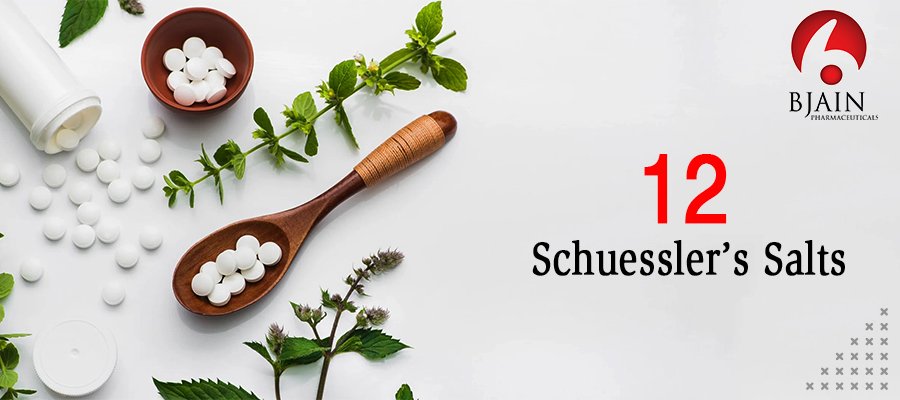Homeopathy is known for its holistic nature and fundamental principle of treating patients with similar medicines. The comprehensiveness of homeopathy is beyond merely one principle. It is more than that. Homeopathy stands on a solid ground that is natural laws and scientific approach.
Did you know homeopathy has something else to fill the gaps too? What gaps are we talking about? Dr. Schuessler gave a theory about the lack and imbalance in the inorganic constituents of the body. Before we dive into this, we need to know about Dr. Schuessler and his contribution to Homoeopathy.
Introduction
Dr. Wilhelm Heinrich Schuessler was born in 1821. He mastered homeopathy and conducted extensive research on physiology and biochemistry; he created a treatment strategy based on compounds that comprise natural function medicines; the 12 tissue salts. The usage of inorganic compounds found in blood and tissues grew organically, inspired by the beliefs of other researchers at the time.
Theory of Schuessler’s salts
Biochemic Therapeutics is founded on the physiological reality that the composition and functionality of the body’s organs are reliant on certain essential amounts and the right allocation of its inorganic ingredients. These persist after the tissues have been combusted and create ashes.
Our body is composed of twelve essential minerals (tissue) salts, and their optimum balance is required for normal cell activity and perfect health. When cellular homeostasis is upset, an aberrant situation develops, leading to various disorders. According to Dr. Schuessler, maintaining a normal balance of these important inorganic salts can be achieved by providing the lacking mineral salts in an uncomplicated absorbable form. These are now called Schuessler Tissue Salts. Schuessler discovered that a homeopathically produced microdose was the most efficient way to digest these salts, as they enter the circulation quickly and into our cells.
Inorganic components of the Cells
Nerve cells’ inorganic components are magnesium phosphate, kali phosphate, natrum, and ferrum. Muscle cells possess the same but with an inclusion of Kali mur. Connective tissue cells contain Silicea as their particular material, whereas elastic tissue cells most likely have Calc. fluor.
Calc. fluor. and Magnesium phos are present in bone tissue, with a high concentration of Calc. phos. This second substance is present in trace amounts in the cells of the nervous system, muscles, brain, and connective tissue. The cartilage and mucous membrane cells contain Natr. mur., an inorganic mineral present in every form of the body. Ferrum, along with other inorganic compounds, may be found in human hair and the lens’s crystalline structure.
12 Tissue Salts and their Indications
A change in the balance of these molecules causes prolapse, dilatation, and loosened elastic fibers. It treats protruding organs, varicose veins, piles, and circulatory malignancies. Calc. Fluor is frequently used to treat hard inflammation and bone abnormalities.
The inability of the body to digest and utilize this salt causes terrible dentition at early ages, delayed growth, and overall weakness. It is the finest tonic after an arduous sickness and is used to treat tuberculosis, bone ailments, malnutrition, anemia, challenging and painful menstrual periods, and adolescence.
The scope of this therapy includes the recovery of suppurative tissue. Used to treat mattery discharges, abscess formation boils, ulcerations, blood problems, arthritis, and other conditions.
It is used to treat diseases caused by disrupted or slow blood flow. Used for fever and swelling. An effective pain treatment that comes with heat, redness, a pounding pulse, and stiffness. Colds, diarrhea, hemorrhages, rheumatism, epistaxis, mild catarrh, bedwetting, and other conditions can all benefit from this remedy.
Useful in all disorders that come with a gray or white tongue coating, heavy white discharge and expectorations, skin conditions, colitis, dysentery, and other maladies that feature exudations, intrusions, inflammation, and the final phases of acute sickness.
The best treatment for nerve illnesses and nervous weakness. For nervous exhaustion, brain weariness, neurasthenia, sleeplessness, loss of confidence, agitation, a frenzy depression, gloominess, tearfulness (with Nat. Mur.), anxious headaches, extremity pain, foul ulcers, and unpleasant secretions.
The yellow-coated tongue is an indicator. At the end of an upper respiratory tract infection or cough, expectoration is simple. The skin is greasy, peels easily, and emits yellow or greenish effluent. The person performs poorly in hot environments and the evening. Useful in catarrhal conditions and for leucorrhea when the pus coming out is yellow.
The use of heat relieves the symptoms. A common treatment for spasmodic disorders characterized by acute, shooting, or piercing sensations. It has been successfully used to treat gas, colic, nerve pain, neurasthenia, heart rate fluctuations, toothache, writer’s cramp, and other problems. It is also an excellent cure for baby belly problems.
It is the initial treatment option for anemia and stunted growth. Used to treat headaches, indigestion, vomiting, thin catarrh, colds with runny discharge, watery blisters, constipation, mental distress, and mal-assimilation problems.
Used to treat all acid-related illnesses and conditions in the body. Used to treat acid reflux, sour stomachs, acid diarrhea, rheumatic illnesses, neurological problems, and worms. The broad yellow tongue serves as a reliable indicator. Good for youngsters who have developed acidity as a result of consuming too many sweets and pastries.
This is an excellent liver and kidney treatment. Typically found in those who are worse in moist conditions. It is used to treat liver problems, biliousness, ill headaches, migraines, bilious vomiting, bitter taste in the mouth, diarrhea, influenza, periodic fever, stones, weak kidney activity, dropsy, and other ailments.
This remedy helps promote the formation of pus and suppuration. Used to treat abscesses and non-discharging boils. Has had excellent effects on more advanced nerve system illnesses, such as paralysis, spasms, and rheumatic symptoms in the limbs. It is also recommended for people who lack self-esteem, and bravery or struggle with an insecurity complex.
Conclusion
Tissue remedies were initially asked to be recognized as a separate system of medicine but the method of preparation, dosage, and prescription indicated its homeopathic standing. These 12 tissue remedies are a wonderful contribution of Dr. Schuessler to the field of Homoeopathy. Biochemic medicines are a useful resource for homeopathic practitioners.
At BJain Pharmaceuticals we provide the highest quality biochemic medicines ensuring all the quality control parameters. We use the traditional mortar and pestle method for the trituration using the highest quality HMS grade lactose. We manufacture soft dissolving tablets with 10 to 20s disintegration time (DT) to facilitate fast absorption.

Dr Aditi
Dr Aditi (BHMS) from NHMC Delhi, HMO ( Chandigarh Administration), Ex- SRF ( CCRH ), currently doing a research study of effect of Homoeopathic medicines in Mother and Child Health care in Chandigarh.


